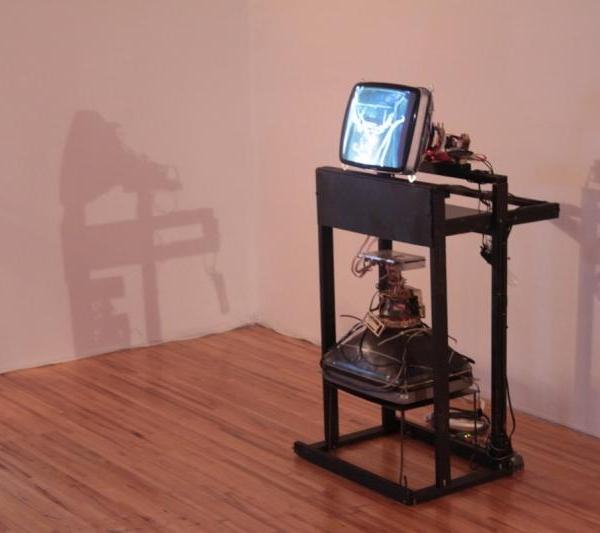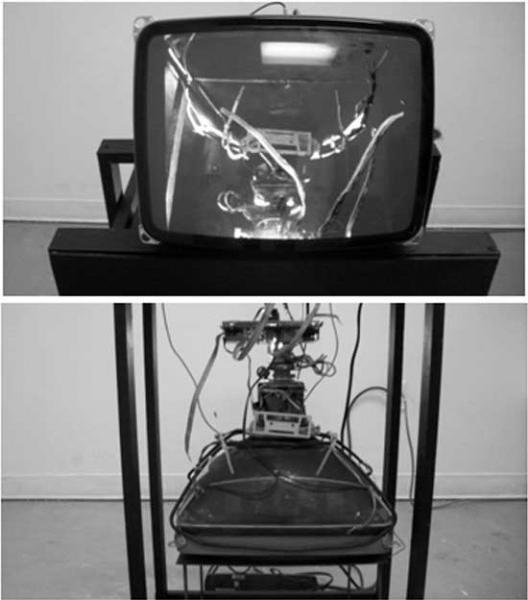
About:
With ‘Untitled (a.k.a. Leonard)‘, a discarded cathode ray (TV) picture tube rests face down on the lower half of the skeleton-like wood structure – its vertebrae. Just above sits a functioning cathode ray (TV) picture tube. Both of these cathode rays (TV) picture tubes, were acquired by skinning two TV sets of their shells, and in turn, exposing their cathode ray tubes and electronic components.
On the screen of the functioning skinned TV set (at the top of the Object) a video image of the discarded TV cathode ray tube (at the bottom of the Object) can be viewed. Except the cathode tube seems to have been inverted so that it is now facing upwards.
When first encountering the image being projected through the functioning skinned TV cathode ray tube (top), one may assume that the source of the image is from a live feed of the discarded TV cathode ray tube located at the bottom of the Object.
As such, one may begin to wave their hands up and around the work to see if this is, in fact, the case, and where the camera may be located. When no perceivable interference occurs, one may even begin to search out the source of the camera. This did occur with visitors on numerous occasions during the exhibition).
However the camera would never be located since the source of the video originates from a encased DVD player (black in color and merged with the black painted wooden vertebrae-like structure of the Object) located just below the functioning skinned TV cathode ray tube (at the top of the Object), which is in fact, playing a prerecorded, three-minute video loop, of the discarded, non-functioning TV cathode ray tube below.

Thoughts on ‘Untitled (a.k.a. Leonard)’
With ‘Leonard’, an intimacy may occur between the Object, and the viewers/participants, due to Leonard’s seemingly vulnerability – its now skinned and exposed presence, its temporal existence revived though an intervention, as its misappropriated parts attempt to merge as one, once again.
Also, as the viewers/participants spend more time with ‘Leonard’, they may begin to notice the subtle shaking of the video image emerging from the TV cathode ray tube (top), and/or hear the soft, irregular clicking sounds emanating from the small speakers which lie passively next to the cathode tube.
Or how ‘Leonard‘ is to be trying to reference itself, between the interaction of the TV cathode ray tubes – memories of it its past existence (below) now imprinted and being played back via a never-ending video loop (above).
Video Death and Resurrection: 29.9 Frames Per Second
Tom Sherman in his lecture Nine Lives of Video: Technological evolution, the repeated near-death of video art, and the life force of vernacular video remarks that “Video art has been pronounced dead so many times; its continual resurrection should not surprise anyone” (13). We tend to forget that today’s seemingly sophisticated technological devices, from computers to handheld devices, to molecular and nanotechnology, are all still dependent on the original interface processes developed by the introduction of television and video (xxi).
All these system/object interfaces rely on the relationship of the viewer to the screen via a control mechanism which allows them to view, manipulate and record information as memory. But what is perhaps most intriguing is how this television/video interface allows its users to turn technological objects on and off – initiating a physical and symbolic death and resurrection of memory as information each time they do so. Perhaps it is no coincidence that the way we now interface and reference information memory is through the digits 1 and 0 – the digit 1 signifying on and 0 for off.
Untitled (a.k.a. Leonard), John Naccarato, The Obscure Objects of Desire and the Rise of the Technological Chimera Exhibit, video excerpt, AXENEO7, Gatineau, QC, Canada, 2010
Untitled (a.k.a. Leonard) and Untitled (a.k.a. Marta), John Naccarato, in Artist’s Studio, Ottawa, ON, Canada, 2009
Further Related Reading & Articles:
Below are links to the individual Hybrid Sculptural Objects and their related texts (published as part of my MFA Thesis, The Obscure Objects of Desire and the Rise of the Technological Chimera: Towards Death and the Other ), 2010. Specific segments have been revised and updated for each post. John Naccarato, 2022
